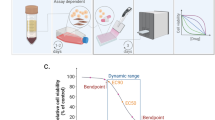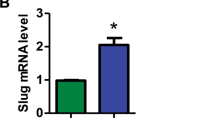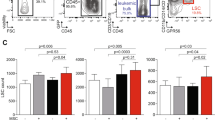Abstract
Leukemic stem cells (LSCs) are considered a major cause of relapse in acute myeloid leukemia (AML). Defining pathways that control LSC self-renewal is crucial for a better understanding of underlying mechanisms and for the development of targeted therapies. However, currently available culture conditions do not prevent spontaneous differentiation of LSCs, which greatly limits the feasibility of cell-based assays. To overcome these constraints we conducted a high-throughput chemical screen and identified small molecules that inhibit differentiation and support LSC activity in vitro. Similar to reports with cord blood stem cells, several of these compounds suppressed the aryl-hydrocarbon receptor (AhR) pathway, which we show to be inactive in vivo and rapidly activated ex vivo in AML cells. We also identified a compound, UM729, that collaborates with AhR suppressors in preventing AML cell differentiation. Together, these findings provide newly defined culture conditions for improved ex vivo culture of primary human AML cells.
This is a preview of subscription content, access via your institution
Access options
Subscribe to this journal
Receive 12 print issues and online access
$259.00 per year
only $21.58 per issue
Buy this article
- Purchase on Springer Link
- Instant access to full article PDF
Prices may be subject to local taxes which are calculated during checkout





Similar content being viewed by others
References
Burnett, A., Wetzler, M. & Lowenberg, B. Therapeutic advances in acute myeloid leukemia. Clin. Oncol. 29, 487–494 (2011).
Dick, J. & Lapidot, T. Biology of normal and acute myeloid leukemia stem cells. Int. J. Hematol. 82, 389–396 (2005).
Hope, K., Jin, L. & Dick, J. Acute myeloid leukemia originates from a hierarchy of leukemic stem cell classes that differ in self-renewal capacity. Nat. Immunol. 5, 738–743 (2004).
Lapidot, T. et al. A cell initiating human acute myeloid leukaemia after transplantation into SCID mice. Nature 367, 645–648 (1994).
Pearce, D. et al. AML engraftment in the NOD/SCID assay reflects the outcome of AML: implications for our understanding of the heterogeneity of AML. Blood 107, 1166–1173 (2006).
Woiterski, J. et al. Engraftment of low numbers of pediatric acute lymphoid and myeloid leukemias into NOD/SCID/IL2Rcγnull mice reflects individual leukemogenecity and highly correlates with clinical outcome. Int. J. Cancer 133, 1547–1556 (2013).
Eppert, K. et al. Stem cell gene expression programs influence clinical outcome in human leukemia. Nat. Med. 17, 1086–1093 (2011).
Gentles, A., Plevritis, S., Majeti, R. & Alizadeh, A. Association of a leukemic stem cell gene expression signature with clinical outcomes in acute myeloid leukemia. J. Am. Med. Assoc. 304, 2706–2715 (2010).
Csaszar, E. et al. Rapid expansion of human hematopoietic stem cells by automated control of inhibitory feedback signaling. Cell Stem Cell 10, 218–229 (2012).
Boitano, A.E. et al. Aryl hydrocarbon receptor antagonists promote the expansion of human hematopoietic stem cells. Science 329, 1345–1348 (2010).
Mayani, H., Flores-Figueroa, E. & Chavez-Gonzalez, A. In vitro biology of human myeloid leukemia. Leuk. Res. 33, 624–637 (2009).
Barabe, F., Kennedy, J.A., Hope, K.J. & Dick, J.E. Modeling the initiation and progression of human acute leukemia in mice. Science 316, 600–604 (2007).
Heuser, M. et al. MN1 overexpression induces acute myeloid leukemia in mice and predicts ATRA resistance in patients with AML. Blood 110, 1639–1647 (2007).
Choi, J.-S., Braymer, J., Nanga, R., Ramamoorthy, A. & Lim, M. Design of small molecules that target metal-A{beta} species and regulate metal-induced A{beta} aggregation and neurotoxicity. Proc. Natl. Acad. Sci. USA 107, 21990–21995 (2010).
Borowiak, M. et al. Small molecules efficiently direct endodermal differentiation of mouse and human embryonic stem cells. Cell Stem Cell 4, 348–358 (2009).
Feng, B., Ng, J.-H., Heng, J.-C.D. & Ng, H.-H. Molecules that promote or enhance reprogramming of somatic cells to induced pluripotent stem cells. Cell Stem Cell 4, 301–312 (2009).
Bone, H., Nelson, A., Goldring, C., Tosh, D. & Welham, M. A novel chemically directed route for the generation of definitive endoderm from human embryonic stem cells based on inhibition of GSK-3. J. Cell Sci. 124, 1992–2000 (2011).
Sauvageau, G. Pyrimido[4,5-b]indole derivatives and use thereof in the expansion of hematopoietic stem cells. PCT/CA2013/050052, WO/2013/110198 (2013).
Denison, M. & Nagy, S. Activation of the aryl hydrocarbon receptor by structurally diverse exogenous and endogenous chemicals. Annu. Rev. Pharmacol. Toxicol. 43, 309–334 (2003).
Henry, E. et al. Flavone antagonists bind competitively with 2,3,7, 8-tetrachlorodibenzo-p-dioxin (TCDD) to the aryl hydrocarbon receptor but inhibit nuclear uptake and transformation. Mol. Pharmacol. 55, 716–725 (1999).
Bouchez, L.C. et al. Small-molecule regulators of human stem cell self-renewal. ChemBioChem 12, 854–857 (2011).
Knockaert, M. et al. Independent actions on cyclin-dependent kinases and aryl hydrocarbon receptor mediate the antiproliferative effects of indirubins. Oncogene 23, 4400–4412 (2004).
Opitz, C.A. et al. An endogenous tumour-promoting ligand of the human aryl hydrocarbon receptor. Nature 478, 197–203 (2011).
Swanson, H. DNA binding and protein interactions of the AHR/ARNT heterodimer that facilitate gene activation. Chem. Biol. Interact. 141, 63–76 (2002).
Denison, M., Soshilov, A., He, G., DeGroot, D. & Zhao, B. Exactly the same but different: promiscuity and diversity in the molecular mechanisms of action of the aryl hydrocarbon (dioxin) receptor. Toxicological sciences 124, 1–22 (2011).
Krüger, T., Long, M. & Bonefeld-Jørgensen, E. Plastic components affect the activation of the aryl hydrocarbon and the androgen receptor. Toxicology 246, 112–123 (2008).
Bhakta, K. et al. Regulation of cytochrome P4501A1 expression by hyperoxia in human lung cell lines: implications for hyperoxic lung injury. Toxicol. Appl. Pharmacol. 233, 169–178 (2008).
Magnusson, M. et al. Expansion on stromal cells preserves the undifferentiated state of human hematopoietic stem cells despite compromised reconstitution ability. PLoS ONE 8, e53912 (2013).
Taussig, D. et al. Leukemia-initiating cells from some acute myeloid leukemia patients with mutated nucleophosmin reside in the CD34(−) fraction. Blood 115, 1976–1984 (2010).
U.S. Department of Health and Human Services, National Toxicology Program, Report on Carcinogens, Twelfth Edition, p. 353 ff. and 396 (2011).
Prud'homme, G.J. et al. Breast cancer stem-like cells are inhibited by a non-toxic aryl hydrocarbon receptor agonist. PLoS ONE 5, e13831 (2010).
Xiao, Z., Hao, Y., Liu, B. & Qian, L. Indirubin and meisoindigo in the treatment of chronic myelogenous leukemia in China. Leuk. Lymphoma 43, 1763–1768 (2002).
Simon, C. et al. A key role for EZH2 and associated genes in mouse and human adult T-cell acute leukemia. Genes Dev. 26, 651–656 (2012).
Hu, Y. & Smyth, G.K. ELDA: extreme limiting dilution analysis for comparing depleted and enriched populations in stem cell and other assays. J. Immunol. Methods 347, 70–78 (2009).
Acknowledgements
We acknowledge M. Fréchette and A.E. Mejia Alfaro for assistance with xenotransplantation experiments, N. Mayotte and S. Fortier for technical assistance with mouse analyses, J. Duchaine for assistance in screens, and D. Gagné and G. Dulude for technical assistance with high-throughput flow cytometry. We thank specimen donors and the Leukemia Cell Bank of Québec for providing primary AML samples and B. Lehnertz and J. Yeh for critical reading. This work was financially supported by grants from Genome Quebec/Canada to G.S., J.H., S.L. and A.M. and from the Cancer Research Network of the Fonds de recherche du Québec–Santé to J.H. G.S. is supported as a Canada Research Chair in Molecular Genetics of Stem Cells, and J.H. is supported as a Research Chair in Leukemia, supported by Industrielle-Alliance (Université de Montréal). C.P. was supported by a postdoctoral fellowship from the German Cancer Aid (Deutsche Krebshilfe) and is currently supported by a Cole Foundation fellowship.
Author information
Authors and Affiliations
Contributions
C.P. designed, executed and analyzed experiments, wrote the paper and generated the figures. G.S., J.H. and J.K. contributed to project conception, experimental design and editing of the manuscript. I.F. helped identify the compound UM729. S.L. and G.B. contributed to RNA-seq data analysis and statistical analyses. A.M. contributed to chemical data analysis and manuscript editing. R.R. designed and produced compound UM729.
Corresponding author
Ethics declarations
Competing interests
The authors declare no competing financial interests.
Supplementary information
Supplementary Text and Figures
Supplementary Figures 1–8 and Supplementary Tables 1–4 (PDF 1510 kb)
Rights and permissions
About this article
Cite this article
Pabst, C., Krosl, J., Fares, I. et al. Identification of small molecules that support human leukemia stem cell activity ex vivo. Nat Methods 11, 436–442 (2014). https://doi.org/10.1038/nmeth.2847
Received:
Accepted:
Published:
Issue Date:
DOI: https://doi.org/10.1038/nmeth.2847
This article is cited by
-
UM171A-induced ROS promote antigen cross-presentation of immunogenic peptides by bone marrow-derived mesenchymal stromal cells
Stem Cell Research & Therapy (2022)
-
A primary hierarchically organized patient-derived model enables in depth interrogation of stemness driven by the coding and non-coding genome
Leukemia (2022)
-
Acute Myeloid Leukemia Stem Cells: Origin, Characteristics, and Clinical Implications
Stem Cell Reviews and Reports (2022)
-
A reporter system for enriching CRISPR/Cas9 knockout cells in technically challenging settings like patient models
Scientific Reports (2021)
-
The BET bromodomain inhibitor ZEN-3365 targets the Hedgehog signaling pathway in acute myeloid leukemia
Annals of Hematology (2021)



